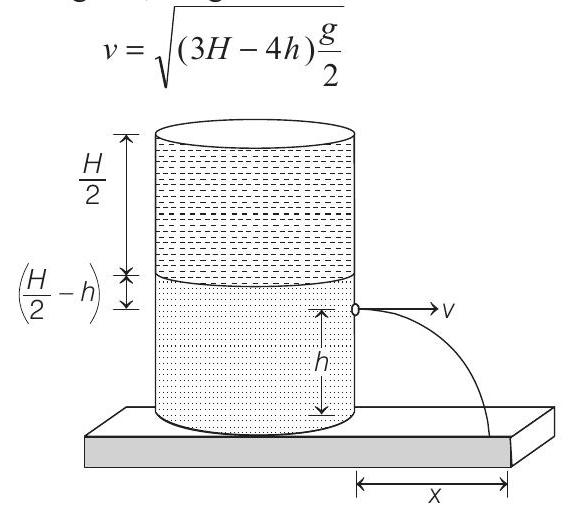Properties Of Matter Ques 78
- Consider two solid spheres $P$ and $Q$ each of density $8$ $gm$ $cm^{-3}$ and diameters $1$ $cm$ and $0.5$ $cm$, respectively. Sphere $P$ is dropped into a liquid of density $0.8$ $gm$ $cm^{-3}$ and viscosity $\eta=3$ poiseulles. Sphere $Q$ is dropped into a liquid of density $1.6$ $gm$ $cm^{-3}$ and viscosity $\eta=2$ poiseulles. The ratio of the terminal velocities of $P$ and $Q$ is
(2016 Adv.)
Show Answer
Answer:
Correct Answer: 78.$(3)$
Solution:
- (a) (i) Considering vertical equilibrium of cylinder
Weight of cylinder $=$ upthrust due to upper liquid + upthrust due to lower liquid
$ \begin{aligned} & \therefore\left(\frac{A}{5}\right)(L) D \cdot g=\left(\frac{A}{5}\right)\left(\frac{3 L}{4}\right)(d) g+\left(\frac{A}{5}\right)\left(\frac{L}{4}\right)(2 d)(g) \\ & \therefore \quad D=\left(\frac{3}{4}\right) d+\left(\frac{1}{4}\right)(2 d) \\ & \Rightarrow D=\frac{5}{4} d \end{aligned} $
(ii) Considering vertical equilibrium of two liquids and the cylinder.
$ \left(p-p _0\right) A=$ weight of two liquids $ + $ weight of cylinder
$\therefore \frac{\text { weight of two liquids }+ \text { weight of cylinder }}{A}$ $\quad$ …….(i)
Now, weight of cylinder
$ =\left(\frac{A}{5}\right)(L)(D)(g)=\left(\frac{A}{5} L g\right)\left(\frac{5}{4} d\right)=\frac{A L d g}{4} $
Weight of upper liquid $=\left(\frac{H}{2} A d g\right)$ and
Weight of lower liquid $=\frac{H}{2} A(2 d) g$
$ =H A g d $
$\therefore$ Total weight of two liquids $=\frac{3}{2} H A d g$
$\therefore$ From Eq. (i) pressure at the bottom of the container will be
$ p=p _0+\frac{\left(\frac{3}{2}\right) H A d g+\frac{A L d g}{4}}{A} $
or
$ p=p _0+\frac{d g(6 H+L)}{4} $
(b) (i) Applying Bernoulli’s theorem,
$ \begin{array}{r} p _0+d g\left(\frac{H}{2}\right)+2 d g\left(\frac{H}{2}-h\right) \\ =p _0+\frac{1}{2}(2 d) v^{2} \end{array} $
Here, $v$ is velocity of efflux at 2 . Solving this, we get

(ii) Time taken to reach the liquid to the bottom will be
$ t=\sqrt{2 h / g} $
$\therefore$ Horizontal distance $x$ travelled by the liquid is
$ \begin{aligned} & x=v t=\sqrt{\left.(3 H-4 h) \frac{g}{2}\right)}\left(\sqrt{\frac{2 h}{g}}\right) \\ & x=\sqrt{h(3 H-4 h)} \end{aligned} $
(iii) For $x$ to be maximum $\frac{d x}{d h}=0$
$ \begin{array}{ll} \text { or } & \frac{1}{2 \sqrt{h(3 H-4 h)}}(3 H-8 h)=0 \\ \text { or } & h=\frac{3 H}{8} \end{array} $
Therefore, $x$ will be maximum at $h=\frac{3 H}{8}$
The maximum value of $x$ will be
$ \begin{aligned} & x _m=\sqrt{\left(\frac{3 H}{8}\right)\left[3 H-4\left(\frac{3 H}{8}\right)\right]} \\ & x _m=\frac{3}{4} H \end{aligned} $





